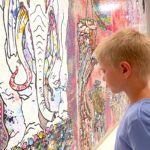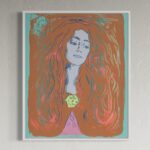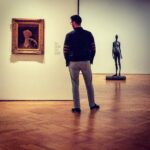Auguste Rodin (French, 1840-1917)
“Femme accroupie de face”
Circa 1900, Graphite on lined Japan paper
29.5 cm x 19.3 cm
Signed at the bottom right A. Rodin
PRICE: ON request to reed@robinrile.com
Christina Uribe Buley writes;
“This rapidly executed drawing of a crouching woman is an excellent example of the technique used by Rodin starting in the mid 1890’s, whereby the models, often either actresses or female dancers, would freely move around in the studio. The drawings that were resulted from these sessions were not classic nudes or studio studies, but portrayals of women simultaneously aggressive and humorous, crouching, pointing their fingers, and sticking their tongues out to the audience. During these sessions, Rodin only had eyes for his models and would deliberately not look at the sheet of paper as he drew. The result is a surprisingly accurate synthesis of the whole body, in which proportions are expressively distorted and muscle forms altered. The Austrian poet Rainer Maria Rilke wrote what is perhaps the best description of these drawings:
“But finally, the day gives birth to these strange instantaneous documents, of that which passes imperceptibly. Rodin suspected that if he could summarize the insignificant moves of the model, unaware of being observed, that they would contain an unexpectedly intense expression, because we are not used to giving them active and deep attention. Keeping the model in sight and applying to the paper his swift and experienced hand, he drew a multitude of gestures previously unobserved, always neglected, and the strength of expressions emanating were immense. Such ensembles of movements never before seen or discerned as part of the form of the whole, were outlined thus, and contained everything there that was immediate, dynamic and passionate in a truly sensual life.”
By executing the drawing without looking directly at the sheet, Rodin impregnated the profiles and reliefs of the human body with meaning, as they evolved in front of him He was then able to transcribe to paper the shape that he had observed in an instant, thanks to the exceptional visual memory acquired during his years of training at the Petite Ecole. The result appears in the form of drawings that were revolutionary at that time.”
~Christina Uribe Buley is the Rodin drawings expert who authenticates Rodin drawings and creates certificates for them (required now by Sotheby’s and Christie’s for more valuable Rodin drawings passing through auction)
*******
 Auguste Rodin (French, 1840-1917)
Auguste Rodin (French, 1840-1917)
“Sapphic Couple” (1898 – 1900)
Graphite on wove paper mounted on board.
24.1 x 31.8 cm
Signed in graphite at the bottom left: A.R.
inscribed on the verso on the board: with stencil, black ink: A. Rodin/Drawing/Frame no. 153;
annotated with brush: a picture framer label 106: Moirinat
Exhibuted: 1900, Paris, Pavillon de l’Alma, number Druet: 153 and hanging number 106
Christina Uribe Buley writes:
“The Sapphic Couple with very refined lines and in which paleness is like an invitation to look very closely, had probably been pre-selecte to be exhibited at the pavillon de l’alma, where Rodin organized his first grand Parisian retrospective. It is not absolutely certain however that it was displayed. It includes all characteristics of the drawing of the alma: it is glued on a board support with a number written with stencil (number 153) has a number inscribed by hand (106) and has the label of the picture framer Moirinat, who was solicited for all the drawings and pictures of this exhibit. However, it doesn’t appear on the list of the works registered in the “Cahiers Gris” (Gray notebook) that details the hanging order of the drawings. The pose of the two lovers was perhaps considered as too audacious to be shown to the naive audience of the World Fair. This drawing very probably suffered the same fate as its preparatory version done with graphite and stumping in the collection of the Rodin Museum (D.5967), and was finished in the portfolios of his “musee secret”. In fact, Rodin kept in his studio, hidden from public eye, hundreds of erotic drawings and small delicieusement impudiques that he never displayed in any exhibit. Only a few favored visitors could leaf through the drawings of this “secret museum“.
~ Christina Uribe Buley, the Rodin drawings expert who authenticates Rodin drawings and creates certificates for them (required now by Sotheby’s and Christie’s for more valuable Rodin drawings passing through auction)





